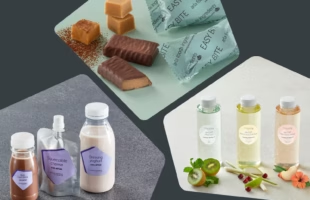
Courtesy of Cargill
In the modern culinary landscape, the delicate dance between indulgence and wellness is more pronounced than ever. Consumers are increasingly seeking experiences that cater not just to their cravings but to their health, demanding a fusion of flavor and function that challenges industry norms.
The art of snacking is more than just a way to stave off hunger—it’s an opportunity to nourish the body and delight the senses. While it’s easy to grab a quick, indulgent treat that promises immediate gratification, thoughtful choices about what we eat between meals can profoundly impact our health and well-being.
Striking a balance between nutritious snacks and those occasional indulgences is crucial. It allows us to enjoy life’s culinary pleasures without compromising our health.
Xiaoling Liu, Indulgence Leader, Food Solutions Asia Pacific, Cargill shares insights about how they’re working to respond to consumer trends while shaping the future of food by crafting innovative solutions that delight and deliver wellness.
Why is the indulgence space important for Cargill?
As our customers look to us for innovative solutions to the fast-evolving consumer trends and taste preferences, Cargill aspires to be our customers’ go-to partner for innovation and growth. To this end, we aim to co-create with them to deliver innovative food solutions that are driven by our deep market insights and research into global and regional consumer trends, e.g., with the annual Cargill TrendTrackerTM, our proprietary perspective on global food and beverage trends.
With our expertise and capability to support our customers end-to-end, from research and development to production and commercialization, we provide a full suite of comprehensive solutions, of which indulgence is one of key growth segments in Asia.
The need to be agile and nimble is more pronounced in Asia Pacific, where there is a diverse group of consumers, and we see APAC as a dynamic playing field for indulgence. With all the buzz around healthfulness, there still is a growing appetite for flavorful and indulgent treats. These are largely driven by a large youth population and rising incomes, coupled with how new and enjoyable experiences around food and beverages are important for consumers.
Delving deeper into indulgence, 33 percent of APAC consumers associate and peg rich flavors and taste as the primary factor of an indulgent food and beverage experience, and the top three ranking texture claims in the region would be creamy, crispy and crunchy. When asked the motivations behind ‘treating’ themselves with food and beverage, 42 percent of consumers cite the fact that it boosts their mood, while 34 percent believes that it provides them comfort. To that extent, we have also seen brands responding with an increased 12 percent in product launches with a mood-related claim.
The indulgence space proves itself to be a growth area and holds much opportunity for innovation and co-creation with our customers.
With our over 40 years of global experience in cocoa and chocolate, having one of the most comprehensive food solutions portfolios in the industry, and expanding sourcing, manufacturing and innovation capabilities in APAC, we believe we are well-positioned to support our customers on their growth ambitions and continue to lead in the indulgence space.
How do we balance indulgence and healthfulness?
The trend of healthy eating is something that we’ve been seeing for a few years now. Consumers today are proactively adopting a holistic approach to health, being more thoughtful and deliberate regarding their food and beverage choices, as well as more discerning about ingredients that go into their foods.
In fact, with ingredient consciousness, we see that most consumers are either trying to limit certain ingredients, or actively seeking certain food, beverages, and ingredients with health benefit in their diet.
“Based on findings reflected in our TrendTrackerTM report, sugar is the top ingredient that APAC consumers are actively trying to limit in their diet.”
This also rings true in the indulgence space and when it comes to chocolate, 50 percent of APAC consumers prefer dark chocolate for its less sweet taste profile and hold the perception that the darker the chocolate, the healthier and more premium it is.
In response, Cargill has developed a range of product with high cocoa content – Pâtissier by Aalst ChocolateTM chocolate artisan dark 85 percent chocolatier and Pâtissier by Aalst ChocolateTM chocolate artisan dark single origin Ghana 75 percent coverture.
This range allows chefs and food professionals to reimagine creations that are health-conscious, while still maintaining the richness and intensity of flavor. Additionally, our customers can also tap on our extensive food solutions portfolio for sugar replacement solutions, from low-to zero-calorie solutions to specialty sweeteners which utilise stevia.
Cargill’s chocolate portfolio also includes products such as Pâtissier by Aalst ChocolateTM chocolate dark couverture 55 percent with no added sugar and Aalst mellow sweet white chocolate 34 percent, to respond to the growing consumer demand in Asia for healthy and mindful consumption.
“Our avenue for innovation does allow us to meet the strong demand that Asian consumers have tasty, flavourful chocolate treats while also being more mindful of the quality, nutritional value and source of the foods they are enjoying.”
Now, consumers want indulgent and healthy products, and both factors are important to them – more are looking for a tasty treat while maintaining nutritional balance. Studies show that within the indulgence space, there has been a six percent CAGR growth for products that have an active health claim, further emphasizing the growth potential of healthy indulgence.
As a response to this need, some of our key customers have also approached us to collaborate on the inclusion of higher protein content into chocolate coffee-based beverages.
Asia for Asia, Bean to bar
Just as there is growing awareness of what is going into their bodies, consumers in APAC are also seeking transparency in terms of sourcing. Sixty-seven percent of APAC consumers actively look out for claims about local sourcing, and 1 in 3 are interested in understanding the product’s “source to shelf” journey.
Cargill has continuously invested in the region and is able to support our customers to meet this trend, with our extensive cocoa sourcing networks, state-of-the art production capabilities, and its deep R&D and innovation expertise. Within Asia, Cargill has been accelerating sustainable cocoa sourcing practices in Indonesia for more than 10 years, complemented by a world-class cocoa processing plant in the country that also houses Asia’s most advanced cocoa development center.
Later this year, the plant in Gresik is set to complete enhancements to its production lines that will support the development of premium cocoa solutions through flavor and color customization.
Further supported by food innovation centers across Asia, Cargill is a food solutions provider with one of the most comprehensive portfolios in the industry and is able to offer its cocoa & chocolate customers access to a wide array of ingredients and solutions, such as specialty fats from edible oils – all of which well positions the company to deliver value, innovation and growth for customers across the region.
Through it all, Cargill is at the forefront of a more sustainable food system and is committed to doing what’s right at every step of the value chain, from sourcing to product. With regards to the cocoa sector, through the Cargill Cocoa Promise, a program to enable farmers and their communities to achieve better incomes and living standards while growing cocoa sustainably, we ensure that our sourcing network is sound and ensures a thriving cocoa sector for generations to come.
Under the Cargill Cocoa Promise program, farmers receive training and 1-on-1 coaching programs in good agricultural and environmental practices, get support in running sustainable cocoa farming and cocoa nurseries, and getting access to agricultural inputs and sustainable market.
This story first appeared in our “State of Snacking: Healthy, Tasty, and Indulgent” issue.








